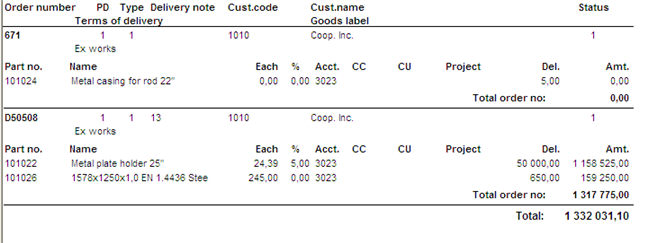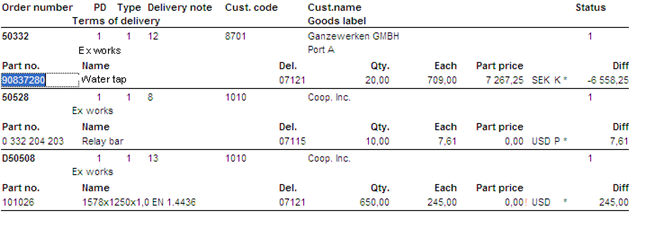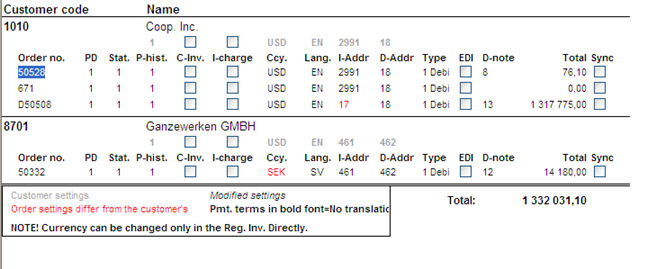Below you will find a few samples of the different list types that can be selected under the Create tab.
At the top of the Standard list you will see the following information for each order: Order number, Customer code, Customer name Status and Goods labeling. Under all this information, you will see the part rows containing information such as: Current delivery period, Actual delivery period, Price each (standard price or material cost excluding SO), Discount, Ordered quantity, Delivered quantity, Amount and Account number. To the far right of the list you will see the reference number (the customer's order number on the order row) which is not the same as the customer's order number in the order header. Beneath the order rows, you will see the order's total amount. At the very bottom of the list, you will see a total amount for all the arrived orders. This list can be valued at standard price.
When classifying the list by Order number you can modify existing invoice bases and select between the Invoice Basis and Print EDI Invoices procedures by selecting or deselecting the EDI column when using the list types Standard and Only total. This is useful if you have registered a new customer but have forgotten to configure the setting regarding EDI invoicing.

Sample of the Standard list.
Sample of a Standard list with the alternative show Paid. Here you will also see a total of the cash discounts, if any.

Sample of the Standard list with the alternative show Paid.
In the Show currencies list, you will see the same information as in the Standard list, except that the order rows' amount is printed in both the company currency and the foreign currency.

Sample of a Show currencies list.
The Only total list shows the total order value per selected classification. This list can be valued at standard price or material cost excluding SO.
If the list is classified by Customer code or Part number, the list also shows information about CM (Contribution margin), CR %, Quantity (parts), Order rows and Project number. If the list is classified by Order number you will also see information about Seller, Our reference, Your reference and Goods label 1-2. However, the additional information shown for these three classification alternatives will not be included in the printouts.
When classifying the list by Order number you can modify existing invoice bases and select between the Invoice Basis and Print EDI Invoices procedures by selecting or deselecting the EDI column when using the list types Standard and Only total. This is useful if you have registered a new customer but have forgotten to configure the setting regarding EDI invoicing.

Sample of an Only total list.
In the Coding list you can enter the coding and pricing of the invoice basis. If coding was performed per cost center, cost unit or project, this will also appear.

Sample of a Coding list.
In the sample below you can also see a column called P. If the symbol * is shown in this column then the part is purchased on project.

Sample of a Coding list with purchase on project.
If you have installed the supplement Warehouse Management, you can use the list type Warehouse to see the following info per order number: Sub-number, Warehouse, Invoice type, Delivery note number, Customer name, Status and the Total order value.

Sample of a Warehouse list.
In the Price check list you can check if there are any differences between the part register price and the invoice basis price. The price check can be made against the price alternatives: Customer price/Price list (auto), Customer price and Price list.
The setting Check against Valid Through Date under the Create tab enables a check of the valid through date for the part price and the future price for the part (provided that the setting Use Future Price in Price Lists, Customer/Supplier Links? is activated). If the order date lies after the valid through date for the part price and a future price is set as part price, the price is shown in bold font. If there is no future price or if the future price has expired, a red exclamation mark (!) is shown after the part price column in the list.
The setting Check against Valid Through Date also enables a check of the staggered prices and future staggered prices (provided that the setting Staggered Sales/Purchase Prices on Parts? is activated). If the ordered quantity is within a certain staggering limit, the staggered price will be set as part price and shown in italics in the list.
If the currency on the order differs from the currency on the part price, an asterisk (*) is shown after the Currency column in the list.
If you have selected to check against Customer price/Price list (auto), you will see a P to the right of the currency column if the part price applies to a price list, and a C if it applies to a customer price.

Sample of a Price check list.
In the Synchronize order header list you can synchronize the information in the order header of existing customer orders such as addresses, terms etc. with the corresponding information from the customer register.
The invoice bases that you want to synchronize are selected in the Sync column. A control question appears where you confirm that the customer order should be modified according to the customer's settings.
The list is classified by Customer code and shows Order number, Partial delivery number (PD) and Status. Furthermore, you can see and synchronize Payment terms (number), Comprehensive invoice, Invoicing charge, Language, Invoice address number, Delivery address number, Invoice type, EDI and Delivery note number. At the end of the list you will see the order amount.
At the bottom of the list you will find an explanation box explaining that: customer settings are displayed in grey; modified settings are displayed in italics; order settings that differ from customer settings are displayed in red; payment terms without translations are displayed in bold.
![]() You cannot change the currency of an order during synchronization, this must be made in the Register Invoices Directly procedure. If the language is changed during synchronization, the text for the payment terms will be translated but no other terms. You cannot synchronize an order with status 9 (Historical).
You cannot change the currency of an order during synchronization, this must be made in the Register Invoices Directly procedure. If the language is changed during synchronization, the text for the payment terms will be translated but no other terms. You cannot synchronize an order with status 9 (Historical).

Sample of a Synchronize order header list.
By using the Info menu which appears if you right-click in all lists you can link to the Register Invoices Directly procedure.
![]() In the lists you can preview orders with status 9 (final delivery made) by pressing F3, right-clicking or double-clicking on the row. This applies to all lists except for lists that are totaled on Part number, Customer code and Delivery note number.
In the lists you can preview orders with status 9 (final delivery made) by pressing F3, right-clicking or double-clicking on the row. This applies to all lists except for lists that are totaled on Part number, Customer code and Delivery note number.